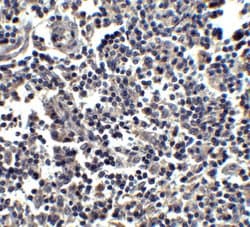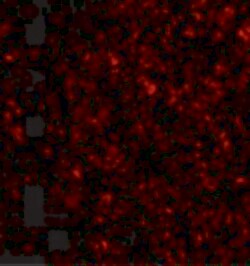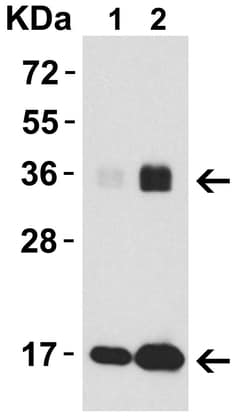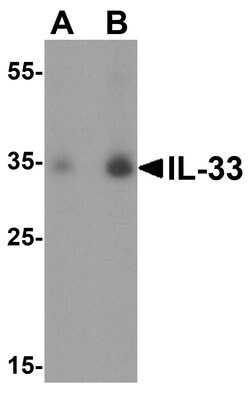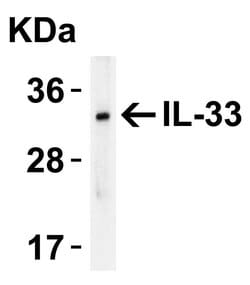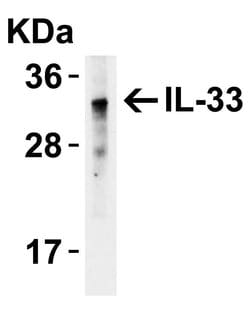Learn More
Invitrogen™ IL-33 Polyclonal Antibody
Rabbit Polyclonal Antibody
Supplier: Invitrogen™ PA520398
Description
The PA5-20398 immunogen is located within the 150-200 amino acids of IL-33. Predicted molecular ~ 31kD. In Western blot applications, this antibody has been observed to detect a band at: 33kD. Despite its predicted molecular weight, IL-33 often migrates at a higher molecular weight in SDS-PAGE. A suggested positive control is human lymph node tissue lysate. PA5-20398 can be used with blocking peptide PEP-0515. Predicted species reactivity based on immunogen sequence: Rat: (76.5%).
IL-33 (Interleukin-33) is a 270 amino acid, highly divergent protein belonging to the IL-1 family with an IL-1-like C-terminal domain. IL-33 is a dual function protein that may function both as a proinflammatory cytokine and an intracellular nuclear factor with transcriptional regulatory properties. IL-33 binds to and signals through IL1RL1/ST2 and its stimulation recruits MYD88, IRAK1, IRAK4, and TRAF6. IL-33 activates NF-kappaB and MAP kinases, and drives production of TH2-associated cytokines from in vitro polarized TH2 cells. In vivo, IL-33 induces the expression of IL-4, IL-5, and IL-13 and leads to severe pathological changes in mucosal organs. IL-33 is proteolytically converted to a mature form by CASP1 and is highly expressed in high endothelial venules found in tonsils, Peyer's patches and mesenteric lymph nodes and is almost undetectable in placenta. Prolonged IL-33 treatment of mice led to the development of eosinophilia, splenomegaly, and severe pathological changes in mucosal organs such as lungs, esophagus and small intestine. Recent experiments have shown that IL-33 can also co-localize with heterochromatin and possesses transcriptional repressor activities, indicating that IL-33 may function as both a proinflammatory cytokine and an intracellular nuclear factor with transcriptional regulatory properties. Despite its predicted molecular weight, IL-33 will often run at higher molecular weight in SDS-PAGE. Studies have shown that IL-33 can also co-localize with heterochromatin and possesses transcriptional repressor activities, indicating that IL-33 may function as both a proinflammatory cytokine, and an intracellular nuclear factor with transcriptional regulatory properties.
Specifications
| IL-33 | |
| Polyclonal | |
| Unconjugated | |
| IL33 | |
| 9230117N10Rik; C9orf26; DVS27; DVS27-related protein; H-IL-33; IL1F11; IL-1F11; Il33; IL-33; ILN; Interleukin; interleukin 33; interleukin-1 family member 11; Interleukin33; Interleukin-33; Interleukin-33 (109-270); Interleukin-33 (95-270); Interleukin-33 (99-270); Interleukin-33(102-266); Interleukin-33(109-266); NFEHEV; NFHEV; NF-HEV; nuclear factor for high endothelial venules; nuclear factor from high endothelial venules; RGD1311155; RP11-575C20.2 | |
| Rabbit | |
| Antigen Affinity Chromatography | |
| RUO | |
| 17082, 77125, 90865, 9173 | |
| Maintain refrigerated at 2-8°C for up to 3 months. For long term storage store at -20°C | |
| Liquid |
| Immunohistochemistry (Paraffin), Western Blot | |
| 1 mg/mL | |
| PBS with 0.02% sodium azide | |
| O95760, P14719, Q01638, Q8BVZ5 | |
| IL1rl1, IL33 | |
| A peptide from near the center of human IL-33. | |
| 100 μg | |
| Primary | |
| Human, Mouse | |
| Antibody | |
| IgG |
Safety and Handling
Your input is important to us. Please complete this form to provide feedback related to the content on this product.
